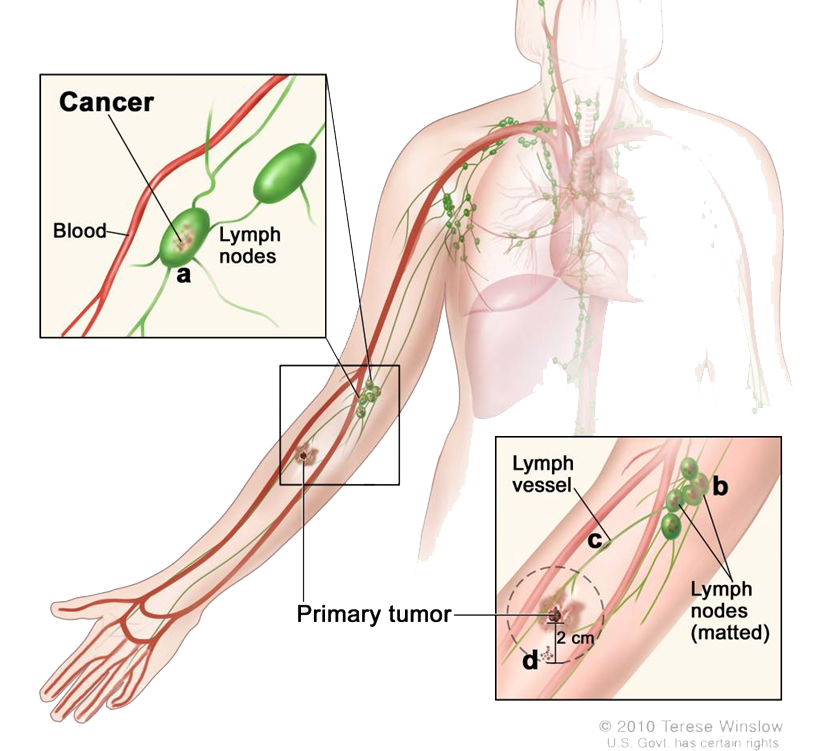Stage 3 Melanoma Cancer ICD 10 is C43.3.
Tap “Watch Now” and for an easy-to-understand overview of Stage 3 Melanoma.
- Stage 3 Melanoma
Overview
A Stage 3 Melanoma diagnosis means that the cancer has spread beyond the skin into your closest lymph nodes. See the point (a) on the image.
In some cases, Stage 3 Melanoma can also mean that the tumor has formed small nodes under the skin around it. Those nodes are called “Satellite” or “In-transit” nodes, depending upon how close or how far they are from where the Melanoma was first found.
Your specific stage, 3A, 3B, 3C or 3D will be assigned to the cancer by your Dr. depending upon how the cancer in your lymph nodes was diagnosed, the number of affected lymph nodes and the presence or absence of Satellite or In-Transit nodes on or under your skin.
What Tests Will I Need and Why?
Blood and Imaging tests are done to understand your general health, confirm your diagnosis and determine your cancer stage.
Tissue analysis is also typically done to identify the cancer cell type and BRAF mutation, which is critical to finding the best treatment option for you. BRAF mutation is present in 40-60% of all melanoma patients.
If your treatment team has not already performed tests to determine your cancer’s features, please ask your doctor when these tests will be performed.
Re-read this summary as needed and then tap, “Compare My Treatment Options Now“. Our unique Comparison Page will help you understand your FDA-approved treatment options including, who can help you pay for your treatment, where and how each is given and what side-effects you may experience.

National Institute of Health/ treatment-melanoma
Recommended Melanoma Cancer Videos

Understanding Melanoma
Causes, Staging & More

What Are The Stages of Melanoma?
Melanoma expert Jeffrey Weber, MD, PhD,

How Cancer Spreads
Metastastis

Diagnosing Your Cancer
How Does a CT Scan Work?

Diagnosing Your Cancer
How Does a PET Scan Work?

Exercise! You Can Do It
Reducing Side Effects & More
Commonly Searched Questions
Stage 3 Melanoma Survival Rate
Source: Cancer.gov
Stage 3 Melanoma Symptoms
- A for asymmetry
- B for borders (uneven)
- C for color (multiple colors in one mole)
- D for diameter (larger than 6mm)
- E for evolving (size, shape, color, elevation of a spot on your skin)
Source: Skincancer.org
Stage 3 Melanoma Treatment
Source: Mountsinai.org
Stage 3 Melanoma Definition
- Stage 3A: The melanoma has spread to 1 to 3 nearby lymph nodes, but the nodes are not swollen, or there is in-transit metastasis (melanoma spread to the skin or subcutaneous tissue between the primary site and regional lymph nodes) but no nodal involvement.
- Stage 3B: The melanoma may have spread to 1 to 3 nearby lymph nodes, and/or there may be in-transit metastasis or satellite melanoma (small clusters of melanoma cells within 2 centimeters of the primary tumor) present. The lymph nodes may be swollen.
- Stage 3C: The melanoma has spread to more than 3 nearby lymph nodes, and/or there is significant in-transit metastasis or satellite melanoma, often with swollen lymph nodes.
Source: Healthline.com
Stage 3 Melanoma Recurrence Rate
Source: Curemelanoma.org
Stage 3 Melanoma Prevention
- Avoid Excessive Sun Exposure: Limit time in direct sunlight, particularly between 10 a.m. and 4 p.m., when UV rays are strongest. Seek shade whenever possible.
- Use Sunscreen: Apply broad-spectrum sunscreen with an SPF of 30 or higher to all exposed skin, and reapply every two hours and after swimming or sweating.
- Wear Protective Clothing: Use hats, sunglasses, and long-sleeved clothing to protect your skin from UV rays. Avoid Tanning Beds: Do not use tanning beds or other artificial sources of UV light, as they increase the risk of melanoma.
- Perform Regular Skin Checks: Conduct monthly self-exams to monitor your skin for new or changing moles or spots, noting any changes in size, shape, or color.
- Regular Dermatologist Visits: Schedule regular skin exams with a dermatologist, especially if you have a history of melanoma, numerous moles, or a family history of the disease.
Source: Curemelanoma.org














